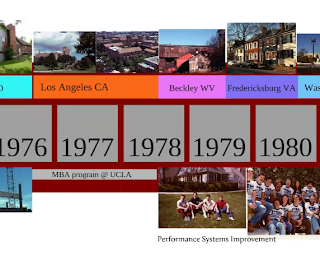If we first choose how to animate a timeline, we've interfered with how well the timeline can work for us. It's far better to first choose how to use the timeline and then let that choice set up the parameters for choosing how to animate the timeline.
There are several different ways to use a timeline in a presentation:
- Ordering a bunch of scattered incidents into a chain of events that unfolded over time to then fill in the gaps, dismiss false accusations or straighten out the story
- Sequencing the stages of a process or separate developments of something that have evolved, merged, cross fertilized or forked over time
- Recognizing patterns that have repeated over time which help theorize what is likely to occur next and why it is likely to happen in a particular way
- Heightening the suspense about what twist of fate is forthcoming or which past torments have been driving current behaviors
 With the use of the timeline selected, the choices for animating the timeline can be considered more strategically to achieve an intended effect. Here are most of those animation choices:
With the use of the timeline selected, the choices for animating the timeline can be considered more strategically to achieve an intended effect. Here are most of those animation choices:-- Assembling a timeline incrementally from individual time periods
-- Moving along and zooming into/out from a completed timeline
-- Placing event icons above or below the actual timeline
-- Zooming into find scaled down event icons hidden within the timeline
-- Starting with a bare bones timeline to gradually complicate with added features, callouts and connections
-- Starting with a completed, messy timeline to incrementally remove components which reveal the bare bones structure
-- Moving forward through the progression of time's arrow
-- Looking backwards to early signs, initial efforts and seeds of later flowering
-- Picturing a single timeline of calendar dates
-- Portraying parallel timelines of efforts, specialties, subgroups etc. which diverge, converge and affect each other's progress
-- Envisioning a straightforward progression from the past to the future
-- illustrating the setbacks, detours, reversals and iterations which contradict linear progress
-- Returning to the timeline as a launchpad to the next exploration
-- Inserting the timeline as a frame of reference while exploring other contexts besides the progression of time
When we already know which use we're going to make of an animated timeline, these choices for how to animate it will look different to us. We will see which alternative better serves the particular use we're making of a timeline.

great post - thank you for pointing out that you should decide how to USE the timeline before deciding how to animate it :)
ReplyDeletethanks for the gratitude Meg!
ReplyDelete